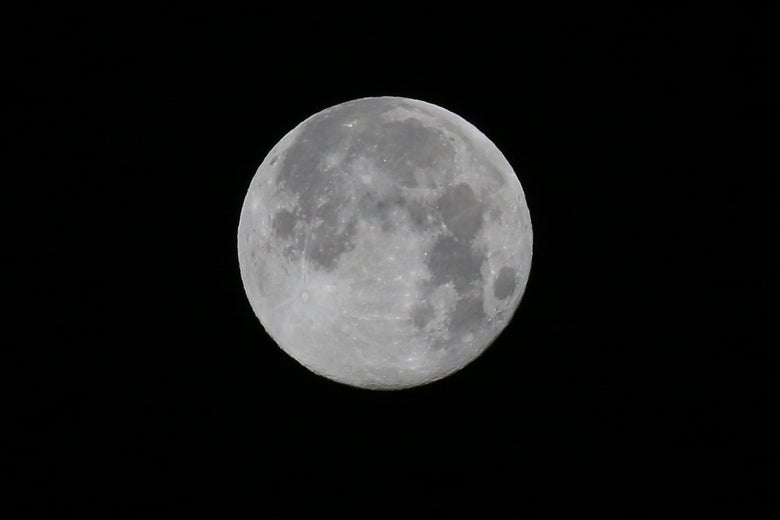

The woman claims that Armstrong gave her a vial of moon dust when she was 10.
Mahmud Turkia/AFP/Getty Images
Last week, a Tennessee woman named Laura Cicco pre-emptively sued NASA so that she could retain possession of a vial of moon dust that she says Neil Armstrong gave her when she was 10. NASA has long maintained that private citizens are not allowed to own lunar material and has seized moon rocks and dust from people in the past so that the artifacts can be put on display for the public. By filing the suit, Cicco hopes to establish legal ownership of the vial.
According to her court filing, Cicco’s father, Tom Murray, was a pilot for the Federal Aviation Administration and the U.S. Army Air Corps during World War II. He and Armstrong were friends and members of a private club of male pilots called the Quiet Birdmen. Cicco’s family lived in Cincinnati in the 1970s, at the same time when Armstrong was teaching aerospace engineering at the University of Cincinnati. That’s when Armstrong gave Cicco the vial of moon dust, the filing says, along with a note reading, “To Laura Ann Murray [her name at the time] – Best of Luck – Neil Armstrong Apollo 11.” Cicco claims she was “unimpressed” upon receiving the gift at the age of 10. “When it was handed to me, I thought that [Armstrong] was just my father’s business partner,” she told Slate.
She rediscovered the vial five years ago while sorting through her parents’ belongings after they had passed away, the Washington Post reported. Cicco and her husband went to attorney Chris McHugh for advice on what to do and learned that NASA has had a history of confiscating lunar material.
“It was scary,” Cicco said of finding out about previous cases. “We’re taking it one day at a time.” Chris Cicco, her husband, said, “I don’t know how [NASA] can claim that everything in space is theirs.” McHugh similarly wrote in the suit, “There is no law against private persons owning lunar material. Lunar material is not contraband.”
One part of the process is proving the moon dust is genuine, which has raised a few questions. To verify the items’ authenticity, McHugh commissioned a series of tests. An analysis of the note and the signature indicated that they matched Armstrong’s handwriting. McHugh sent the dust to Tom Tague, a scientist specializing in molecular spectroscopy, who ran two tests of his own. One test indicated that the material’s composition is similar to “average crust of Earth,” while the other indicated that the material is “consistent with the known composition of lunar regolith.” He speculates in the report that there is likely some dust from the Earth mixed in with the lunar material, which may be a result of vacuuming the dust off of a space suit, and concludes that it is a “likely lunar sample.”
Robert Pearlman, a space historian and artifact collector, saw holes in the report. The main one concerns the conclusion that the dust is “likely from the anorthositic highlands and not from the basaltic lunar mare.” As Pearlman points out, the Apollo 11 mission landed on the lunar mare, also known as the Sea of Tranquility. Astronauts didn’t visit the moon’s highlands until later Apollo missions, well after Armstrong had retired. “The sample, if it is of lunar origin, based on that testing did not come from the area where Neil landed,” said Pearlman.
Tague, the scientist, says he’s unsure how highlands material would have made it into the vial. “My responsibility is essentially just to run the test,” he told Slate. “What happens to some sample going from one place to the other, I have no idea.” He said dust samples from different areas of the moon tend to be very similar. A more definitive determination of the dust’s exact geographical origin would likely require NASA’s cooperation, though. “[NASA] is the possessor of all the samples that would be of interest for that study,” he said.
The legal portion of the case is familiar ground for McHugh. He represented an Illinois woman named Nancy Lee Carlson in a 2017 case about moon dust. Carlson had purchased a bag for lunar samples from a government auction for $955. She sent it to the Johnson Space Center in Houston to verify its authenticity, where NASA scientists discovered that the bag had actually been used by Armstrong to collect samples during the Apollo 11 mission and still contained dust. NASA tried to claim ownership over the bag. Carlson sued, and a federal court eventually ruled in her favor. She later auctioned the bag off at Sotheby’s for $1.8 million.
McHugh, though, says that there are a few salient differences between Carlson’s and Cicco’s cases. In Carlson’s suit, the dispute had more to do with the bag itself than it did with the lunar material. Cicco’s case, on the other hand, is much more focused on the dust. Carlson had bought the bag directly from the government, while Cicco received the vial as a gift from Armstrong. “That will be a question in the case: Did Neil Armstrong have the ability to give this to Laura?” he said. “My view is that the only way to say that Neil Armstrong didn’t have the authority to do that is to say he stole it and had it illegally. I don’t think that’s true.”
Read Again Why a Woman Is Suing NASA to Keep a Vial of “Moon Dust” : https://ift.tt/2JOVTCtBagikan Berita Ini














0 Response to "Why a Woman Is Suing NASA to Keep a Vial of Moon Dust"
Post a Comment